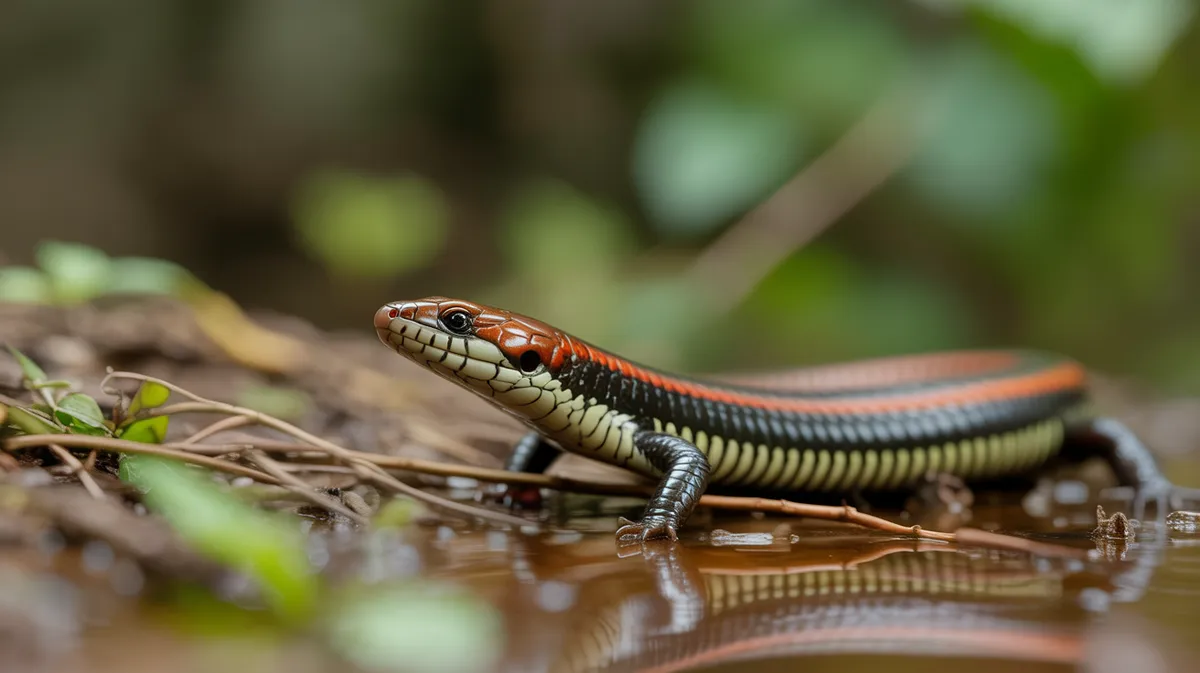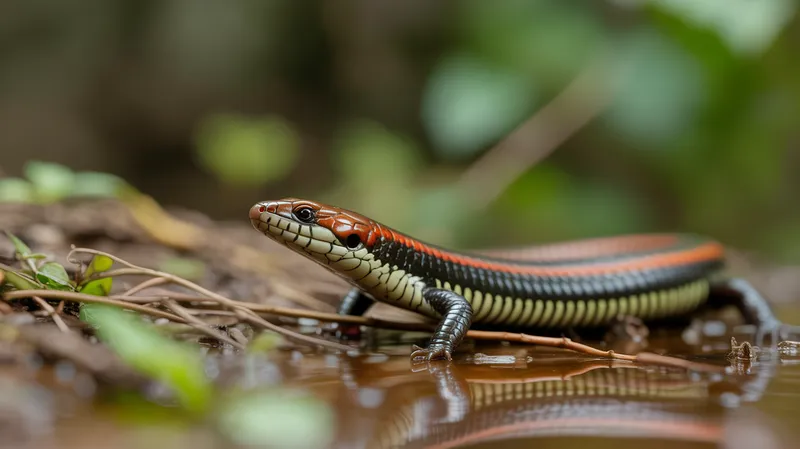
Fire Skink
Mochlus fernandi

Meet the Fire Skink
The Fire Skink is a brightly colored, medium-sized lizard native to West and Central Africa, renowned for its vivid red, gold, and black scales. Highly secretive and terrestrial, it spends much of its time burrowing beneath leaf litter and logs in humid forest environments. Its smooth, glossy body and swift movements make it an elusive sight in the wild, but it is a popular species in the pet trade due to its striking appearance and docile temperament. Fire Skinks are diurnal and rely on their agility and camouflage to evade predators.
Classification
Reptile
Habitat
Humid forest floor
Diet
Carnivore
Lifespan
10-15 years
Conservation
Least Concern
Weight
40-70 grams
📖Fascinating Facts
Dazzling Colors
Fire Skinks are named for their brilliant red and gold coloration, which helps them blend in with the leaf litter and sunlight-dappled forest floors.
Tail Shedding
When threatened, Fire Skinks can shed their tails to distract predators, a process known as autotomy.
Shy Nature
These skinks are secretive and spend most of their time burrowed under logs, leaves, or soil, only emerging to hunt or bask.
📋Detailed Description
The Fire Skink (Mochlus fernandi) is a robust, medium-to-large skink, typically reaching 30–37 cm (12–14.5 in) in total length, with a cylindrical body and smooth, glossy scales that enhance its vibrant coloration. Its dorsal surface is adorned with alternating bands of metallic red, gold, and black, while the ventral side is pale or cream-colored. The head is wedge-shaped, with small, dark eyes and a pointed snout, aiding in burrowing. Limbs are well-developed, each ending in five slender toes tipped with sharp claws for digging. The tail is long and slightly laterally compressed, serving both as a fat reserve and a defensive mechanism; it can be autotomized (shed) to escape predators. Fire Skinks are primarily terrestrial and secretive, spending much of their time concealed under leaf litter, logs, or in self-dug burrows. They are diurnal, emerging during the day to forage and bask in filtered sunlight. Their keen sense of smell and vision are crucial for detecting prey and avoiding threats. In the wild, they are solitary, with little evidence of social grouping outside of breeding. Their striking coloration may serve as both camouflage among forest detritus and as aposematic (warning) signaling to potential predators.
💡 Did you know?
Fire Skinks are capable of regenerating their tails after shedding them, though the new tail is often less vibrant and differently shaped than the original.
🔬Research & Sources
Wikipedia Summary
The fire skink, also known commonly as Fernand's skink, the Togo fire skink, and the true fire skink, is a fairly large skink, a species of lizard in the family Scincidae. The species is known for its bright and vivid coloration. Native to tropical forests in West and Central Africa, the fire skink lives fifteen to twenty years. This species is a diurnal lizard that burrows and hides. It is relatively shy and reclusive, but may become tame in captivity.
Last Modified: 5/26/2025
🎭Behavior & Social Structure
Fire Skinks are active foragers, employing both sit-and-wait and active hunting strategies to capture a variety of invertebrates, including insects, spiders, earthworms, and occasionally small vertebrates. They use rapid, darting movements to ambush prey, relying on their acute vision and chemosensory abilities. When threatened, they may freeze, burrow rapidly, or employ tail autotomy. Fire Skinks are generally solitary and territorial, with individuals maintaining overlapping home ranges but avoiding direct interaction outside of the breeding season. They exhibit crepuscular peaks in activity, often foraging in the early morning and late afternoon. In captivity, they may become accustomed to human presence and display increased boldness, but in the wild, they remain elusive and shy.
👶Reproduction & Life Cycle
Mochlus fernandi is oviparous, with breeding typically occurring at the onset of the rainy season (March–July in much of its range). Courtship involves tactile and chemical cues, with males pursuing and nuzzling females. Females lay clutches of 5–9 elongated, leathery eggs in moist, concealed sites such as under logs or within burrows. Incubation lasts approximately 40–60 days at optimal temperatures (26–29°C/79–84°F). There is no parental care post-oviposition; hatchlings are fully independent and measure about 6–7 cm (2.4–2.8 in) at birth. Sexual maturity is reached at 2–3 years of age under natural conditions.
🛡️Adaptations & Survival
Fire Skinks possess several adaptations for a fossorial (burrowing) and secretive lifestyle. Their smooth, overlapping scales reduce friction during movement through soil and leaf litter. The robust, muscular body and strong limbs facilitate digging and rapid burrowing. Their coloration provides both disruptive camouflage in dappled forest light and potential warning to predators. The ability to autotomize the tail is a key anti-predator adaptation, with regeneration occurring over several months. Behavioral plasticity allows them to exploit a range of microhabitats, from primary rainforest to secondary growth and even agricultural edges, provided sufficient humidity and cover are present.
📚Research Sources
🎨Cultural Significance
While not widely featured in folklore, Fire Skinks are sometimes regarded as symbols of vitality and beauty due to their striking appearance. In some West African communities, brightly colored lizards are believed to bring good luck or serve as omens. Their popularity in the international pet trade has increased their visibility, but there is little evidence of traditional medicinal or ritual use specific to this species.
🔬Recent Research & Discoveries
Recent molecular phylogenetic studies have clarified the taxonomy of Mochlus fernandi, distinguishing it from closely related species within the Mochlus and Lygosoma complexes. Ongoing research is investigating the species' ecological role in soil aeration and invertebrate population control. Studies on captive husbandry have contributed to improved welfare standards and breeding success, reducing pressure on wild populations. There is growing interest in the species' physiological adaptations to humidity and temperature fluctuations, with implications for understanding resilience to climate change.
🎥Wildlife Videos

Wildlife - Just Reptiles | Free Documentary Nature
Wildlife - Episode 3: Just Reptiles | Wildlife Documentary Watch 'Wildlife - Episode 4' here: https://youtu.be/SNRyvGzDsww ...
Free Documentary - Nature

221B Reptiles: Fire skinks! (Lepidothyris fernandi)
A short video about fire skinks.
221B REPTILES

The Amazing Facts About Fire Skinks
These lizards have quite a glossy, vibrant appearance. They can reach lengths of between 10 and 14 inches. These fire skinks ...
ReptileHQ

Fire Skink, The Best Pet Lizard?
The Togo Fire Skink (Lepidothyris fernandi) is a beautiful lizard with a fantastic personality; one of the best pet reptiles you can get ...
Clint's Reptiles

Interesting facts about African skink by weird square
pet #animal : The most, new, latest, shocking, weird, scary, funny, fascinating, interesting and amazing things | facts in the world.
Animal Square

Cold-Blooded Wonders - The Secret Lives of Snakes and Lizards | Full Documentary
Wrapped up in myths and misunderstandings, “cold-blooded” Reptiles are a diverse group with thousands of species crawling, ...
Free High-Quality Documentaries
🌍Habitat Information
The Fire Skink typically inhabits Humid forest floor environments. Fire Skinks have adapted to their environments with specialized features and behaviors.
Primary Habitat:
Humid forest floor
More detailed habitat information will be available soon.
🛡️Conservation Status
The Fire Skink is currently classified as Least Concern. Conservation efforts are crucial for preserving this species for future generations.
Common Threats:
- 🏠Habitat loss and fragmentation
- 🌡️Climate change impacts
- 🎯Hunting and poaching
- 🏭Human-wildlife conflict
⚠️Threats & Conservation Challenges
Currently classified as Least Concern by the IUCN, Fire Skink populations are considered stable across much of their range. However, localized threats include habitat loss due to deforestation, agricultural expansion, and urbanization. Collection for the pet trade, while not currently a major threat, has led to regional declines in some areas. Fire Skinks are sensitive to desiccation and require humid microhabitats, making them vulnerable to changes in forest structure and microclimate. Climate change and increased frequency of forest fires may pose future risks. There are no major targeted conservation actions, but the species benefits from occurrence in several protected areas.
🔬Scientific Classification
Scientific Name
Mochlus fernandi
Classification Hierarchy
🔍 About Taxonomic Classification
Taxonomic classification is a hierarchical system used by scientists to classify and organize living organisms based on shared characteristics and evolutionary relationships.
The system moves from broad categories (Kingdom) to increasingly specific ones, with each animal's scientific name typically consisting of its Genus and species.
📝Community Notes
Share your observations and insights about the Fire Skink with our community of wildlife enthusiasts.
Join Our Community
Sign in to share your observations and connect with fellow wildlife enthusiasts.
Sign In to ContributeNo community notes yet
Be the first to share your observations about the Fire Skink!
Explore Fire Skink
Select a tab above to learn more about this amazing animal.
📸Photo Gallery
No photos available for this animal yet.
🌟Discover More Wildlife
Continue your journey of discovery with more fascinating animals from our database
